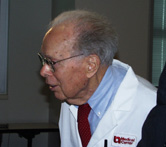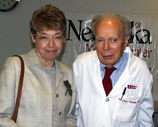 It was a magazine article titled “Tomorrow You May Be Younger” that first led Denham Harman, M.D., Ph.D., to ponder the cause of aging.
It was a magazine article titled “Tomorrow You May Be Younger” that first led Denham Harman, M.D., Ph.D., to ponder the cause of aging.
The year was 1945.
Since then, the Millard Professor and emeritus professor of internal medicine at UNMC has gained international acclaim for his widely accepted aging theory. Known as the father of the free radical theory of aging, Dr. Harman also discovered the role of antioxidants (vitamins C, E and beta-carotene) in fighting heart disease and cancer.
In recognition of his pioneering work, family and friends of Dr. Harman, through the University of Nebraska Foundation, established the Denham Harman, M.D., Ph.D., Lectureship in Biomedical Gerontology. Richard J. Hodes, M.D., director of the National Institutes on Aging (NIA), one of the 25 institutes and centers of the U.S. National Institutes of Health in Besthesda, M.D., was the guest speaker Friday at the inaugural lectureship.
“The strides his institute and Dr. Harman are making in aging research benefit us all,” said Jane Potter, M.D., UNMC professor and chief, section of geriatrics and gerontology.
Dr. Harman’s research on aging is based on the theory he proposed in 1954 — that free radicals, highly reactive molecules freed in the normal chemical processes of living, cause aging and disease through their destructive actions in cells and tissues. At first, his theory was ridiculed and dismissed by many in the scientific community. It gained acceptance in the 1980s and now is considered a theory of aging.
 Dr. Harman, 86, an internist and chemist, believes people need extra supplies of antioxidant vitamins such as vitamin E, vitamin C and beta carotene and follows his own advice, taking regular doses of the supplements. He also continues his research on the aging process, searching for ways to extend a person’s healthy life span.
Dr. Harman, 86, an internist and chemist, believes people need extra supplies of antioxidant vitamins such as vitamin E, vitamin C and beta carotene and follows his own advice, taking regular doses of the supplements. He also continues his research on the aging process, searching for ways to extend a person’s healthy life span.
“The lectureship was established with the hopes that medical students and clinicians will have an opportunity to learn the means and the potential for extending the functional life span,” said Dr. Harman’s wife, Helen. “I don’t think my husband, at any point, has ever suggested that old age was a goal in itself but rather to have meaningful years to work and enjoy life.”
Humans have been trying to uncover the “fountain of youth” for ages — to find ways to live longer. During the Roman Empire, 2000 years ago, the average life span was 30 years. In 1900 it was 48 years, and in 2002, it’s now estimated at nearly 80 years. The record for the longest living human belongs to a 122 year-old French woman.
Since the beginning of the 20th century, life expectancy at birth in the United States has increased from less than 50 years to more than 76 years, according to the NIA. It is projected that by the year 2030, the number of people age 65 and older will reach 70.3 million, constituting 20 percent of the population, placing a significantly greater number of people at risk for disease and disability.
“Our aim at the NIA is to learn the secrets contributing to a healthy old age and to understand the increased risk of disease and disability associated with growing older,” Dr. Hodes said. “The challenge for the 21st century is to make these added years as healthy and productive as possible and to maintain the current trend of decline in disability.”
The NIA has developed specific initiatives to address several geriatric diseases, disorders, and conditions, including: Alzheimer’s disease and other degenerative diseases of the nervous system; age-related changes in memory; major geriatric concerns, including weakness and falls, delirium, urinary incontinence, sleep disturbances, depression, and comorbidities; cardiovascular disease; cancer; diabetes; bone, muscle, skin, joint and movement disorders; vision, hearing, and other sensory disorders; benign prostatic hyperplasia; and infectious diseases.
For nearly his entire career, Dr. Hodes has dedicated his research work to a variety of capacities at the NIA and the National Institutes of Health. A renowned researcher and investigator in fields such as immunology and oncology, Dr. Hodes was named director of the NIA in 1993.
“The experience Dr. Harman brings to the field is really an illustration of how critical novel modes of thinking can be,” Dr. Hodes said. “He came from a background in chemistry and was able to translate that perspective to relevance to biology, in particularly his understanding of free radicals and the possibility that they might involve damage to the molecules that mediate life. That really led to his career and stimulated and triggered a whole field of research.”
Dr. Harman, a native of San Francisco, helped establish the American Aging Association, a lay-scientific organization patterned after the American Heart Association to promote aging research, in 1970. The father of four also is a co-founder of the International Association of Biomedical Gerontology.
“We’re talking about a major problem, the chemistry of how we get old and die,” Dr. Harman said. “The more we now about the mechanism by which this happens, the better able we’ll be to slow up this process and have longer, healthier lives — which is our goal.”